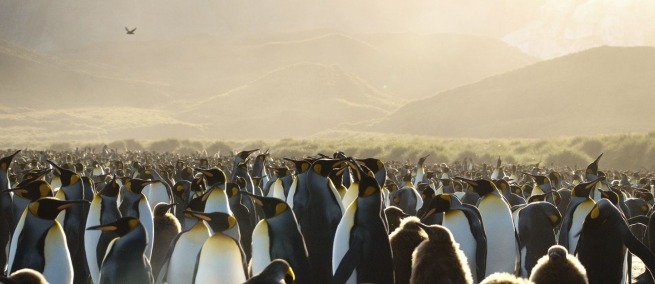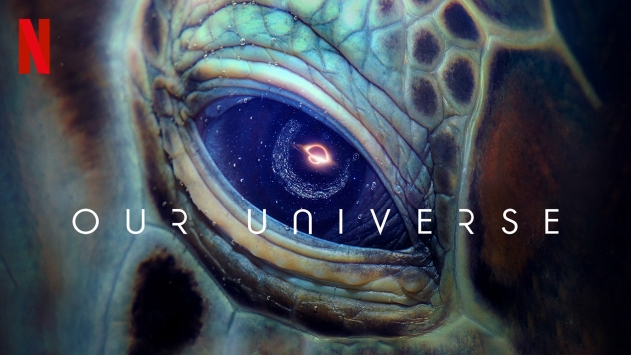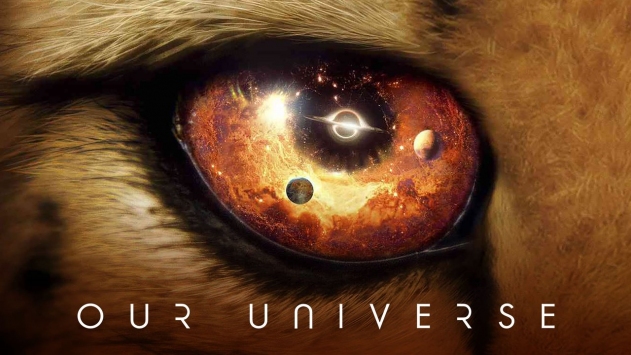
From BBC Studios, narrated by Academy Award-winner Morgan Freeman, the six-part documentary series OUR UNIVERSE blends wildlife footage with modern CGI technology to illustrate our cosmos’ genesis through present-day survival stories of six animals across the globe. The show aims to fascinate viewers of all ages by exploring connections between our life on Earth with the dramatic celestial events that make it possible. We spoke with showrunner Mike Davis (GREAT BARRIER REEF WITH DAVID ATTENBOROUGH, NATURAL HISTORY MUSEUM ALIVE) about the two-year collaborative process with scientists and artists which brought the show to life, and its impact on his worldview.
All six episodes of OUR UNIVERSE are currently streaming on Netflix.
Science & Film: Could you tell me about the inception of the project, how long it took you, and what the process looked like?
Mike Davis: It’s well over two years in the making. It takes a long time to film across the world, as you can imagine. All the different animals, the different times of year that we wanted to film them, and then all the CGI. It takes a long time to storyboard, build, animate, composite, and render. But the concept was clear from the start: telling big stories of space, the history of time, and the universe can often feel like a cold subject, quite removed from our own experience. The original idea was to relate those quite cold, distant, cosmic stories with the very warm animals that we relate to emotionally.
[The show includes] stories about us but told through the lens of these six different iconic animals. Following their stories and relating them directly to these distant, long-ago events gives them a new meaning. I think it allows you to approach them from a different angle. And I'm hoping that we serve both the audiences who love dense, space science stories, and the family audiences that love natural history. That they come away after watching this series having gotten an amazing natural history story, but also learning a lot more about how everything is connected to the stars, that was the dream. The aim was to have some minds blown by connecting life on Earth with space in ways that perhaps the audience hadn't thought of before.
S&F: Could you tell me a little bit more about how you were able to whittle down the series' structure? How did you arrive at the six animals you chose?
Mike Davis: It’s a good question. And as you can imagine, these [episodes] are quite carefully constructed. Ordinarily, a natural history series might set out to film behavior over a long period of time and construct the drama of what's been observed afterwards, whereas we're trying to tell the story of the universe but through the experiences of these animals at the key points in their lives. The agreement with Netflix very early on was that these are fables in some way. They're quite timeless, there are no humans in the background, there's no obvious contemporary conservation message. We wanted to blow the audience’s minds and let them realize how precious our planet is through the connections in the stories. In many ways we find the animal through the space story.
For example, the amazing story of how Mars lost its water and how we held on to it because of Earth’s mass and its magnetic fields, we tried to find the most potent story within the natural world that spoke to that. In this case it’s the elephants, these huge mammals that are so dependent upon water, and have it in abundance much of the year but then it's taken away from them in the Okavango for long distances of time. How they’ve evolved to seek out water and find ingenious ways to do so just felt like the perfect story.
We always wanted the stories to feel like one compelling single narrative that just happened to be compressing huge amounts of time. The bear story perhaps speaks best to that. I wasn't aware of the [giant-impact] hypothesis that a collision created the moon and created the tilt of the Earth, which gives us our seasons. There, we wanted a seasonal story: the bears survival through the winter and the amazing chain of events that lead to the salmon arriving for the bear to feed its cubs.
I suppose it was just trying to find that brilliantly archetypal and recognizable natural history story that spoke to the wider universe story. How the turtle must spend forty years at sea to seek those elements that allow it to survive. How gravity has created the environment where penguins are able to see the ultraviolet markings of another penguin. We wanted to have six very different animals in six very different locations facing six very different challenges. I suppose when they work best, you feel like that space story is a direct cause and effect on whether the animal will live or die, even though you might have, you know, four billion years separating that inciting incident and the survival of the animal.

Promotional Image from OUR UNIVERSE
S&F: Throughout the writing process, production, and post-production, what was the role of your academic consultants?
Mike Davis: Within the science unit of the BBC there’s a lot of expertise. So already, the directors and researchers came to it with a very good understanding, especially of the cosmos. Even though I’d made science shows before, I came more from natural history. I’d just been working with David Attenborough on various series. Coming in was a lovely crash of these two components and it worked well. We had various scientific consultants helping us to make connections and to flesh out some of the connections that we were already making. In some cases, they helped us to find a better one. The scientific relationship that was beautifully borne out in this series was with various institutions in the UK that are creating massive simulations of galaxy formation. In the case of Earth’s impact in the bear story, they've created these accurate physical simulations using billions of points of data. Twenty years ago, in a more traditional discovery documentary that told the story of space, it may have been told with a much more basic rendering.
We had incredibly complex simulations that were done in a scientific capacity which was then brought to the visual effects artists at Lux Aeterna who added their artistry to create something that looks cinematic and gorgeous, as if an IMAX camera was out there in space to capture the colors, the explosion, and the beauty of [Theia’s theoretical collision with Earth.] That's where I feel proud, the big cosmic pieces were underpinned with real physics but still harness a Hollywood beauty. It’s accessible for an audience but has a bedrock of real science.
S&F: It sounds to me like a symbiotic collaboration. Is there anything that you learned through the process of making the show, or something that you look at differently now? Almost every artist I speak to feels a little bit changed by each project they work on or has had a shift in perspective.
Mike Davis: Yes, as soon as bigger connections were made, it surprised me, and I hope it surprises the audience as well. I had never thought about how everything works in such a beautifully elegant and simple way, despite it being incredibly complex. I must admit, something I hadn't known was how animals are able to travel over huge distances. I’ve filmed on the Great Barrier Reef and Raine Island, which is this tiny little sand island off the Queensland coast. A lot of green sea turtles are born on that island and then travel at sea for forty years. It felt elegant to connect iron and heavy metals from supernovas to the very elements within the turtle’s brains that allows it to travel thousands of kilometers to make its way back to this very tiny island. I suppose I never had to think about natural history stories in such a way before, because we'd never tried to explore the science of what motivates and drives and creates opportunity for these animals.
We had an amazing creative license to jump inside the animal and to see how the mitochondria work within the cheetah, and then connect that to the process that's happening within our nearest star. It automatically creates opportunity for a broader, more sweeping story of how everything, including the universe, is born and lives and dies. It allows us to tell stories that are a bit more lyrical and poetic than you might ordinarily have a license to do, in a regular, blue chip, natural history documentary. I guess through that, it allows you to examine your own experience. This is all about the human experience.

Promotional Image from OUR UNIVERSE
S&F: Given that you had such rich fodder, and you had this creative license, do you think that there's a chance for another season or additional episodes? Is this a structure you would be interested in revisiting?
Mike Davis: I’d love to. There are certainly more animals to explore, big iconic animals and more connections with cosmic events. We touched upon evolution in this series, but there's a lot that lies between the cosmic genesis of some of these moments and our animals today. Our penguin stories touch upon how the animals have evolved to adapt to some of those big events, but I’d love to explore more about how they've adapted to life on earth.
The fact that there aren't any humans present [in the series] was deliberate in order to make these feel like quick, timeless fables with some magical realism to them but not at the expense of stressing the urgency of protecting the planet. One thing I've tried to explain when talking about this is, for all the random chance events that have happened over billions of years, this is still the only planet that we know, with liquid water on its surface and with any life, let alone a huge diversity of life. One of the key things I'd love for audiences to take away from this is, it's a precious and rare planet. We're so lucky to be on it right now.
♦
More from Sloan Science and Film:
TOPICS